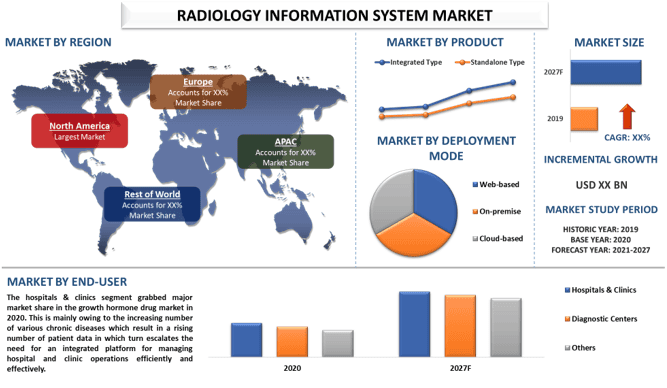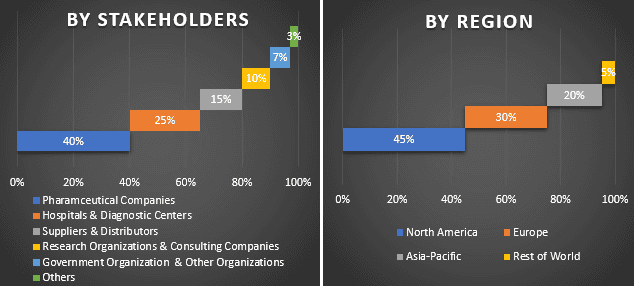Рынок информационных систем радиологии: текущий анализ и прогноз (2021-2027)
Акцент на режиме развертывания (веб-ориентированный, локальный и облачный); Продукте (интегрированный тип и автономный тип); Конечных пользователях (больницы и клиники, диагностические центры и другие); Регион/Страна

Ожидается, что мировой рынок информационных систем радиологии будет расти с повышенным среднегодовым темпом роста (CAGR) около 7% в течение прогнозируемого периода (2021-2027 гг.).Информационная система радиологии (RIS) — это сетевая программная система для управления медицинскими изображениями и связанными с ними данными. RIS особенно полезна для отслеживания заказов на радиологические исследования и информации о выставлении счетов и часто используется в сочетании с системами архивирования и передачи изображений и больничными информационными системами для управления архивами изображений, ведением учета и выставлением счетов.
Растущее население мира увеличило число пациентов с хроническими заболеваниями, что повысило спрос на информационные системы радиологии в больницах. Кроме того, рост распространенности хронических заболеваний, таких как сердечно-сосудистые заболевания и артрит, может перегрузить персонал больниц в ближайшем будущем.Для например, по данным CDC, с 2013–2015 годов, ежегодно около 58,5 миллионов взрослых в США. Прогнозируется, что к 2040 году их число достигнет 78 миллионов (26%) взрослых в США.. Кроме того, растущее внедрение современных технологий медицинскими учреждениями стимулирует рост рынка информационных систем радиологии.
NextGen Healthcare, GE HEALTHCARE, Koninklijke Philips NV, Bayer AG, Medinformarix Inc., Cerner Corporation, Allscripts Healthcare Solutions, IBM Waston Health, LLC, PERFECT IMAGING и Siemens AG — вот некоторые из известных игроков, действующих на рынке информационных систем радиологии. Этими игроками было предпринято несколько слияний и поглощений, а также партнерств, чтобы предоставить клиентам новые разновидности информационных систем радиологии.
Глобальное воздействие COVID-19 было беспрецедентным и ошеломляющим: отрасли стали свидетелями негативного шока спроса во всех регионах в условиях пандемии. Однако рынок информационных систем радиологии столкнулся с положительным ростом во время пандемии. Во время пандемии из-за строгих правительственных постановлений медицинские учреждения откладывали свои несущественные физические приемы и предлагали онлайн-услуги, что увеличило спрос на информационные системы радиологии для лучшего управления.
Информация, представленная в отчете
Среди режимов развертывания сегмент на основе облака занимает основную долю»
В зависимости от режима развертывания рынок делится на веб-ориентированный, локальный и облачный. Сегмент на основе облака захватил значительную долю рынка в 2020 году, и ожидается, что он будет расти быстрыми темпами в ближайшие годы. Это в основном связано с появлением более быстрых интернет-услуг и увеличением проникновения Интернета пациентами и медицинскими учреждениями, что способствует сегментарному росту облачных систем на рынке информационных систем радиологии.Например, по данным анализа Kepios, в январе 2022 года в Индии насчитывалось 658,0 миллионов пользователей Интернета. Уровень проникновения Интернета в Индии составил 47,0 процента от общей численности населения на начало 2022 года, а число пользователей Интернета в Индии увеличилось на 34 миллиона (+5,4 процента) в период с 2021 по 2022 год.
«Среди продуктов интегрированный сегмент занимает основную долю»
В зависимости от продукта рынок делится на интегрированный тип и автономный тип. Интегрированный сегмент получил значительную долю рынка в 2020 году, и ожидается, что он продемонстрирует более высокий среднегодовой темп роста (CAGR) в течение прогнозируемого периода. Повышенная эффективность работы и сокращение времени обработки связаны с растущим внедрением интегрированных систем на рынке RIS. Интеграция RIS и систем архивирования и передачи изображений напрямую повышает эффективность за счет автоматизации рабочего процесса радиологии. Это достигается путем устранения барьеров между изображениями и информацией, что сокращает время обработки отчетов и значительно улучшает обслуживание пациентов и направляющих врачей.
«Среди конечных пользователей сегмент больниц и клиник занимает основную долю»
В зависимости от конечных пользователей рынок делится на больницы и клиники, диагностические центры и другие. Сегмент больниц и клиник получил значительную долю рынка в 2020 году, и ожидается, что он станет свидетелем роста в течение прогнозируемого периода. Наличие квалифицированных специалистов и инфраструктуры для лечения множества заболеваний отвечает за прибыльный рост больниц и клиник на рынке RIS. Кроме того, растущее население мира в сочетании с ростом числа пациентов, страдающих хроническими заболеваниями, увеличивает спрос на системы RIS в больницах.Например, по данным анализа, население мира по состоянию на 2020 год растет со скоростью около 1,05% в год. Текущий средний прирост населения оценивается в 81 миллион человек в год.
«Северная Америка представляет собой один из крупнейших рынков информационных систем радиологии»
Для лучшего понимания динамики рынка информационных систем радиологии был проведен подробный анализ различных регионов мира, включая Северную Америку (США, Канада и остальная часть Северной Америки), Европу (Германия, Франция, Испания, Великобритания, Италия и остальная часть Европы), Азиатско-Тихоокеанский регион (Китай, Индия, Австралия, Япония и остальная часть АТР), проведен остальной мир. В 2020 году Северная Америка занимает значительную долю в индустрии информационных систем радиологии. Это в основном можно объяснить наличием хорошо развитой диагностической инфраструктуры и значительного числа радиологов в регионе.Например, по данным Бюро статистики труда США, в США до 2021 года было занято 29 530 радиологов, а их средний годовой доход составлял 301 720 долларов США.
Причины купить этот отчет:
- Исследование включает в себя определение размеров рынка и анализ прогнозирования, подтвержденные аутентифицированными ключевыми отраслевыми экспертами.
- В отчете представлен краткий обзор общей производительности отрасли с первого взгляда.
- Отчет содержит углубленный анализ выдающихся отраслевых коллег с уделением основного внимания ключевым финансовым показателям бизнеса, портфелю продуктов, стратегиям расширения и последним разработкам.
- Детальное изучение движущих сил, ограничений, ключевых тенденций и возможностей, преобладающих в отрасли.
- Исследование всесторонне охватывает рынок по различным сегментам.
- Углубленный анализ отрасли на региональном уровне.
Варианты настройки:
Мировой рынок информационных систем радиологии может быть дополнительно настроен в соответствии с требованиями или любым другим сегментом рынка. Кроме того, UMI понимает, что у вас могут быть свои собственные потребности в бизнесе, поэтому не стесняйтесь связаться с нами, чтобы получить отчет, который полностью соответствует вашим требованиям.
Содержание
Методология исследования для анализа мирового рынка информационных систем радиологии (2021-2027 гг.)
Анализ исторического рынка, оценка текущего рынка и прогнозирование будущего рынка мирового рынка информационных систем радиологии — это три основных шага, предпринятые для создания и анализа внедрения информационных систем радиологии в основных регионах мира. Для сбора исторических рыночных данных и оценки текущего размера рынка были проведены исчерпывающие вторичные исследования. Во-вторых, для подтверждения этих данных были приняты во внимание многочисленные результаты и предположения. Кроме того, были проведены исчерпывающие первичные интервью с отраслевыми экспертами по всей цепочке создания стоимости мирового рынка информационных систем радиологии. После предположения и подтверждения рыночных данных посредством первичных интервью мы применили подход «сверху вниз/снизу вверх» для прогнозирования полного размера рынка. После этого были приняты методы разбивки рынка и триангуляции данных для оценки и анализа размера рынка сегментов и подсегментов отрасли. Подробная методология объяснена ниже:
Анализ исторического размера рынка
Шаг 1: Углубленное изучение вторичных источников:
Подробное вторичное исследование было проведено для получения исторического размера рынка информационных систем радиологии через внутренние источники компании, такие какгодовые отчеты и финансовая отчетность, презентации о результатах деятельности, пресс-релизы и т. д.и внешние источники, в том числежурналы, новости и статьи, правительственные публикации, публикации конкурентов, отраслевые отчеты, сторонние базы данных и другие заслуживающие доверия публикации.
Шаг 2: Сегментация рынка:
После получения исторического размера рынка информационных систем радиологии мы провели подробный вторичный анализ для сбора исторических данных о рынке и доли для различных сегментов и подсегментов для основных регионов. Основные сегменты, включенные в отчет, — это режим развертывания, продукт и конечные пользователи. Дальнейший анализ на уровне стран был проведен для оценки общего внедрения информационных систем радиологии во всем мире.
Шаг 3: Факторный анализ:
После получения исторического размера рынка различных сегментов и подсегментов мы провели подробныйфакторный анализдля оценки текущего размера рынка информационных систем радиологии. Кроме того, мы провели факторный анализ с использованием зависимых и независимых переменных, таких как растущее число людей с хроническими заболеваниями и растущее пожилое население во всем мире. Был проведен тщательный анализ сценариев со стороны спроса и предложения с учетом ведущих партнерств, слияний и поглощений, расширения бизнеса и запуска продуктов в секторе информационных систем радиологии по всему миру.
Оценка и прогноз текущего размера рынка
Определение текущего размера рынка:Основываясь на практических данных, полученных из вышеуказанных 3 шагов, мы определили текущий размер рынка, ключевых игроков на рынке информационных систем радиологии и доли рынка сегментов. Все необходимые доли в процентах, разделение и разбивка рынка были определены с использованием вышеупомянутого вторичного подхода и проверены посредством первичных интервью.
Оценка и прогнозирование:Для оценки и прогнозирования рынка были назначены весовые коэффициенты различным факторам, включая движущие силы и тенденции, ограничения и возможности, доступные для заинтересованных сторон. После анализа этих факторов были применены соответствующие методы прогнозирования, т. е. подход «сверху вниз/снизу вверх», для получения прогноза рынка примерно до 2027 года для различных сегментов и подсегментов на основных мировых рынках. Методология исследования, принятая для оценки размера рынка, включает:
- Размер рынка отрасли в стоимостном выражении (доллары США) и уровень внедрения радиологической информационной системы на основных рынках внутри страны
- Все процентные доли, разбивки и детализации рыночных сегментов и подсегментов
- Ключевые игроки на рынке радиологических информационных систем с точки зрения предлагаемых продуктов. Также стратегии роста, принятые этими игроками для конкуренции на быстрорастущем рынке
Проверка размера и доли рынка
Первичные исследования:Были проведены углубленные интервью с ключевыми лидерами мнений (KOL), включая руководителей высшего звена (CXO/VP, руководители по продажам, руководители по маркетингу, руководители по операциям и региональные руководители, руководители стран и т. д.) в основных регионах. Результаты первичных исследований были затем обобщены, и был выполнен статистический анализ для подтверждения заявленной гипотезы. Данные первичных исследований были объединены со вторичными данными, превращая таким образом информацию в практические выводы.
Разбивка первичных участников по различным регионам

Разработка рынка
Метод триангуляции данных был использован для завершения общей оценки рынка и получения точных статистических данных для каждого сегмента и подсегмента рынка радиологических информационных систем. Данные были разделены на несколько сегментов и подсегментов после изучения различных параметров и тенденций в областях режима развертывания, продукта и конечных пользователей рынка радиологических информационных систем.
Основная цель исследования рынка радиологических информационных систем
В исследовании были определены текущие и будущие рыночные тенденции радиологических информационных систем. Инвесторы могут получить стратегическое представление для принятия решений об инвестициях на основе качественного и количественного анализа, проведенного в исследовании. Текущие и будущие рыночные тенденции определили общую привлекательность рынка на региональном уровне, предоставив платформу для участника отрасли, чтобы использовать неиспользованный рынок, чтобы получить выгоду в качестве первого шага. Другие количественные цели исследований включают:
- Проанализировать текущий и прогнозируемый размер рынка радиологических информационных систем в стоимостном выражении (доллары США). Также проанализировать текущий и прогнозируемый размер рынка различных сегментов и подсегментов
- Сегменты в исследовании включают области режима развертывания, продукта и конечных пользователей
- Определение и анализ нормативно-правовой базы для отрасли радиологических информационных систем
- Анализ цепочки создания стоимости, связанной с присутствием различных посредников, а также анализ поведения клиентов и конкурентов отрасли
- Анализ текущего и прогнозируемого размера рынка радиологических информационных систем для основного региона
- Основные регионы, изученные в отчете, включают Северную Америку, Европу, Азиатско-Тихоокеанский регион и остальной мир
- Профили компаний рынка радиологических информационных систем и стратегии роста, принятые участниками рынка для поддержания на быстрорастущем рынке
- Углубленный анализ отрасли на региональном уровне
Связанные Отчеты
Клиенты, купившие этот товар, также купили










